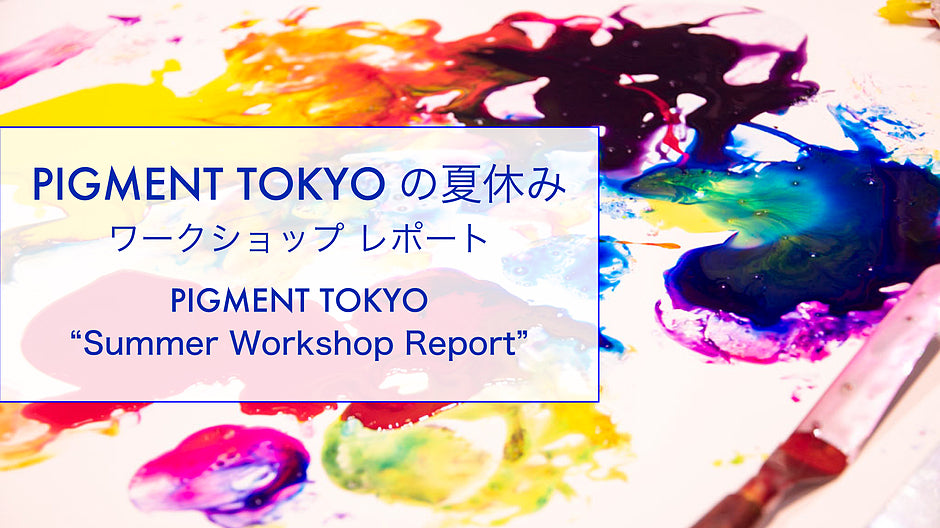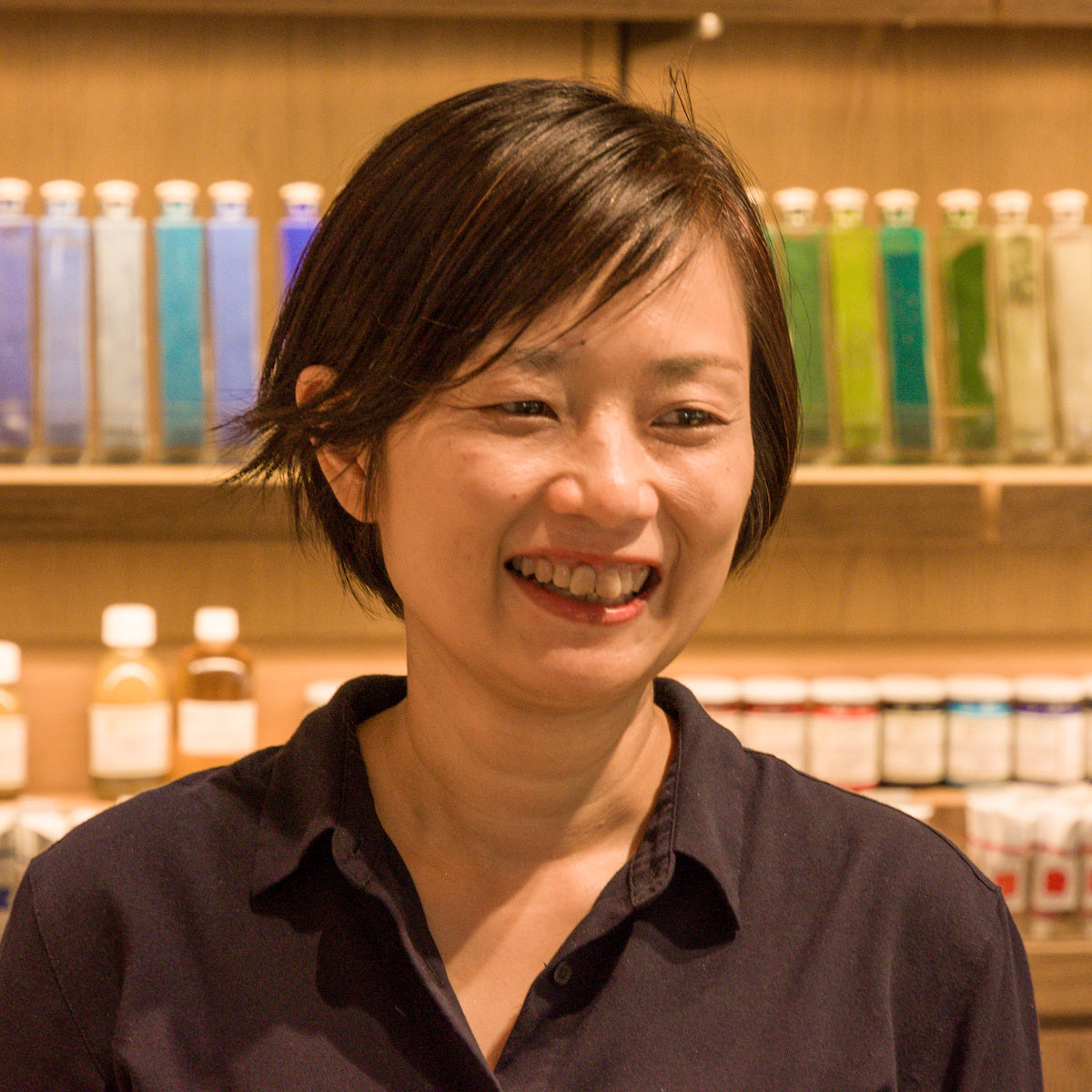Every summer, we hold exciting art-related workshops here at PIGMENT TOKYO.
Therefore this year, we had our usual popular workshops by brushing up a little along with some new workshops to make this summer more interesting!
This article will be a final report about these workshops that were held during the summer holiday.
First of all, I would like to start with one of the most popular workshops for both parents and children to enjoy, "Creating Original Color Wheel."

Creating Original Color Wheel
This workshop was designed for children to learn and create while having fun with colors. It was instructed by Kei Saito, who teaches our monthly workshops such as "Creating Original Paints."
In this workshop, Kei Saito used the three primary colors, cyan (blue-green), magenta (red-violet), and yellow, which are the most fundamental.
First, drip the special paints made from pigment paste and binder onto YUPO paper, then blend all the colors to form a beautiful marbling design.

If you observe how the paints are blended closely, you will notice the delicate changes between each color.
Once the colors are well mixed, transfer the paint to large and small circular pieces of paper as if you were “collecting” the colors, then let them dry.

After that, place these circular-shaped papers on white paperboard. After adjusting the balance and composition of each paper and design, glue them on the board, and it is ready to display!
This kind of gluing technique is called "collage" and it can be applied to a wide variety of works by simply changing the shape and size of the parts.

Next, I would like to introduce another workshop, "Learn Japanese Traditional Art Materials," which was so popular that has now become one of our annual workshops.

Learn Japanese Traditional Art Materials
The instructor of this workshop is Natsumi Yamasato, who teaches Japanese painting workshops such as “Introduction to Mineral Pigment”.
The lecture is based on her studies as an artist and researcher of reproducing traditional Japanese paintings, therefore, her talk will surely be interesting for both children and parents to learn about the charm of art materials.
Next, if we move on to the practical part, you can start with "paint making," a process of kneading mineral pigments and animal glue together with fingers.
Also, the substrate we use in this workshop may remind you of the golden screen called Kin-byobu (金屏風) in Japanese.
Even working from the same drawing, different painters can create different expressions with various color combinations and touches, resulting in a hundred different artworks.

The photo below shows a worksheet specially made for this workshop by our instructor, Natsumi Yamasato. Your children may use it as a research report for their summer break homework.
In this workshop, she prepared two types of worksheets according to your child's grade.
It would also be fun to review the workshop with your family at home or play a quick quiz together using this worksheet.


The worksheet above is for late elementary grades.
It is written in kid-friendly Japanese vocabulary and kanji characters depending on your child’s age group.
Next, I would like to introduce our newly released workshop, " Creating Original Pastel."
This year, we held a face-to-face workshop at PIGMENT TOKYO and an online live streaming workshop.

Creating Original Pastel

As some of you may know, the materials for making pastels are pretty simple.
We only need pigments, gum arabic, water, extender pigments, etc.
The instructor will explain every step carefully by comparing it with examples that we are familiar with, such as “It is good to think of making pastels as ‘making udon noodles’.”

Unlike the "Creating Original Color Wheel," which requires you to work intuitively, for making pastels, you have to measure the ingredients one by one with a measuring spoon or dropper.
However, you do not have to worry too much about making a small mistake because our instructor will be there to help and give advice.

Once the color paste is kneaded well until it has a certain hardness, it is ready to be shaped into a cute little cylinder form.
The pastels need to be left for another day or two to dry before they’re ready to be used for coloring.
Also, the pastels made in the workshop will be placed in a special box so you can take them home with ease.
As a PIGMENT TOKYO staff myself, I truly hope the participants enjoyed the texture and smoothness of the pastels when they drew, which is quite different from using crayons.
Last but not least, we had PIGMENT TOKYO's first live-streaming workshop that included practical time.

[Live-streaming] Creating Original Pastel
The participants joined the workshop from their homes through the Zoom Meeting with the art materials we sent to them in advance. Most art materials were the same as those used in the face-to-face workshop, however, we made some small arrangements for certain tools to make them easier to use at home.
Since it was our first time to have a workshop through the Zoom Meeting, we kept it as a small group and it turned out great because of the overall relaxed and homely atmosphere.
During the online workshop, if there was anything they didn't understand, they could always ask the instructor for help and advice.
In the end, the instructor and staff were as happy as the participants to see that everyone created their pastels successfully even though they were joining the workshop from different places.
It made us so excited as you can see from the picture below, our instructor is smiling through the camera.
This picture shows what it was like behind the scenes.

The lecture and demonstration were taken while switching between the two cameras. Throughout all the time, we made sure that the instructor's hands and actions were clearly captured, so participants could follow the instructor step by step.
The best part of taking online workshops is that it allows those who live far away or who are aware of traveling to participate. Furthermore, you can also use leftover art materials to continue creating even after the workshop is over. We are planning to offer even higher level online workshops in the future, so please keep your eyes on us for more updates!
Other than that, PIGMENT TOKYO does not hold only regular workshops but also special lectures according to seasons and events.
In the fall of 2021, we will be holding a collaboration workshop with the "Who is Banksy?" exhibition, which started on August 21.

[Limited-time Offer] Stencil Gold Leaf
Date: 2021/09/23 (Thu), 10/02 (Sat), 10/09 (Sat), 11/06 (Sat), 11/27 (Sat)
Time: 11:00-12:00 / 14:00-15:00
Reservations: https://pigment.tokyo/en/collections/workshop
*This event has ended.
Find the latest information about our workshops here.
https://pigment.tokyo/en/collections/workshop
In this workshop, you will experience stencil graffiti using Japanese art materials such as metal leaves and stencil templates.
By experimenting with the "transfer technique," you may deepen your knowledge of Banksy's artwork.
This workshop includes a ticket to the "Who is Banksy?" exhibition which is located in the museum next door.
Perhaps you could spend some artistic autumn this year in Tennoz Isle!
Regular workshops are suitable for adults and children of all ages to experiment with and learn about art materials.
For reservations and details, please visit the following URL page.
It is PIGMENT TOKYO’s hope that our workshops will serve as a bridge to connect people with art materials, techniques, and creativity.
Translated by Atsumi Okano
PIGMENT TOKYO Art Materials Expert



